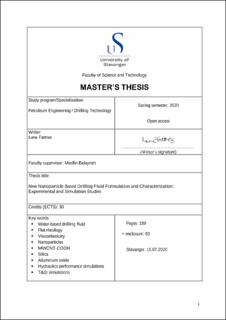| dc.description.abstract | Drilling fluids are an essential part of any drilling operation and it offers several functions of great importance, such as controlling the wellbore pressures and transporting cuttings to the surface. The design of a drilling fluid is greatly dependent on its performance, cost and environmental impact. To ensure a safe and successful drilling operation, the drilling fluid must be designed according to the expected wellbore conditions, such as the surrounding formation and thermodynamic state of the wellbore. Due to the global energy demands, the petroleum industry is expanding its exploration activities to depleted reservoirs, artic, deepwater and geothermal wells, where a stable drilling fluid with enhanced properties is required.
The main issue with the use of bentonite fluids at higher temperatures is the flocculation of the bentonite platelets and the changes in the rheological properties it brings. The focus of this thesis is to design a thermally stable water-based drilling fluid containing both bentonite and various polymers. Thereafter, the impact of multi-walled carbon nanotube, silica and aluminum oxide nanoparticle suspensions on the flat rheology fluid is investigated. All fluids are characterized by their rheological, filtration, viscoelastic and frictional properties. Lastly, the performance of the flat rheology fluid and the optimum nanoparticle systems were investigated by performing hydraulics and T&D simulations.
Initially, a water-based drilling fluid containing soda ash, pac, polypac, bentonite and barite was formulated. This fluid was further modified with 0.016 wt% carbopol which provided the system with flat rheology characteristics. The thermal stability of the fluid was also verified by the hydraulics performance simulation where both the pump pressure and ECD are maintained at higher temperatures.
From the modification of the flat rheology fluid with the nanoparticle suspensions, it was found that the optimum concentrations were ~0.014 wt% MWCNT-COOH, ~0.025 wt% silica and ~0.014 wt% aluminum oxide. Results showed that these concentrations reduced the fluid loss of the flat rheology fluid with 23 %, 31 % and 32 %, respectively. Moreover, the lubricity was improved with 36.9 %, 23.1 % and 35.6 %, respectively. From the T&D simulations, it was observed that the increased lubricity reduced the torque and drag forces encountered in the wellbore significantly, which allows for longer drilling. | en_US |

